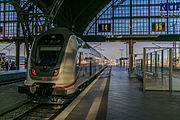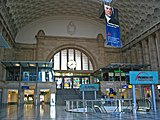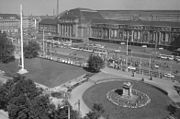Leipzig Hbf
The station is owned by DB InfraGO, a subsidiary of Deutsche Bahn, and is classified as a Category 1 station, one of twenty in Germany. It also functions as a large shopping centre. Train services are operated by Deutsche Bahn, S-Bahn Mitteldeutschland, Erfurter Bahn and Mitteldeutsche Regiobahn. As of 2008, Leipzig Hauptbahnhof handled an average of 120,000 passengers per day.
In 2021, Leipzig Hauptbahnhof was ranked the best railway station in Europe.
History


After the opening of the Leipzig–Dresden railway line in 1839, followed by the Magdeburg-Leipzig railway one year later, the Leipzig–Hof railway in 1842, and the Leipzig–Großkorbetha railway in 1856, Leipzig had become the most important railway junction in the Kingdom of Saxony. Initially trains departed from separate termini, such as Bayerischer Bahnhof, located southeast of the Leipzig city centre. While the city's population increased sharply, especially upon German unification in 1871, the spatial separation proved to be complicated and ineffective.
By 1895, the Saxon railway lines were nationalized under the umbrella of the Royal Saxon State Railways, while the lines of the former Magdeburg–Halberstadt, Berlin-Anhalt, and Halle-Sorau-Guben railway companies had been incorporated into the Prussian state railways. Already in 1875, plans for the establishment of a united German imperial railway organisation, as proposed by Albert von Maybach, had failed due to the antagonism of the Central German states, notably by the Saxon government. Therefore, two state railways rivalled to meet the demands of a steadily growing transport volume in the Leipzig area.

Finally in 1898, the Leipzig city council decided on a joint terminal for Royal Saxon and Prussian state railways north of the city centre. A building contract with both organisations was signed in 1902 and an architectural competition with 76 participants was held in 1906. The winning design by the architects William Lossow (1852–1914) and Max Hans Kühne (1874–1942) featured two identical domed entrance halls facing the street, one for each company. The foundation stone was laid on 16 November 1909 and the platforms were gradually brought into operation station from 1912 onwards. When construction works finished on 4 December 1915, Leipzig Hauptbahnhof had become one of the world's largest railway stations with 26 platforms.
The separate administration of the Saxon and Prussian parts of the station continued even after World War I and the establishment of the nationwide Deutsche Reichsbahn railway organisation in 1920. Not until 1934 Leipzig Hauptbahnhof as a whole was assigned to the Reichsbahn directorate in Halle. By 1939, it had become one of Germany's busiest railway stations. The building was severely damaged by Allied bombing during World War II when during an air raid by the US Eighth Air Force on 7 July 1944 the roof over the concourse collapsed and the western entrance hall was destroyed. Numerous travellers and railway employees were killed. Rail traffic discontinued completely in April 1945.

After the war, train service was quickly resumed. The hardly damaged eastern entrance hall was restored by 1949, and the western hall was rebuilt to its original appearance by the Deutsche Reichsbahn railway company of East Germany in the early 1950s. The concourse, however, remained without a roofing, until in 1954 the East German Council of Ministers resolved upon a complete reconstruction. The full restoration of Leipzig Hauptbahnhof was finished on 4 December 1965, 50 years after its inauguration.
After German reunification the station was renovated and modernized by the Deutsche Bahn AG. The concourse floor was removed and two basement levels were dug out to create a shopping mall. Other areas of the building were largely restored and modernized at the time. The Design and Planning were done by the architectural firm HPP based in Düsseldorf. The modified station building was inaugurated on 12 November 1997.
The Leipzig City Tunnel, an underground railway line between the south of Leipzig and Hauptbahnhof via the central Markt station, opened on 14 December 2013. Further modifications of platforms and tracks are currently being carried out in the course of the construction of the Erfurt–Leipzig/Halle high-speed railway line, part of the European Berlin–Palermo railway axis.
-
Concourse after modification
-
Interior during Christmas
-
First train at the Leipzig City Tunnel on 14 December 2013
Historic exhibits
On the site of closed track No. 24, several historical Deutsche Reichsbahn locomotives are on display:
- Class 52 steam locomotive 52 5448-7
- Class SVT 137 Diesel multiple unit 137 225
- Class E04 AC electric locomotive E04 01
- Class E44 AC electric locomotive E44 046
- Class E94 AC electric locomotive E94 056
Movie set
Leipzig Hauptbahnhof served as a backdrop for several films, such as
- Shining Through (1992)
- Obsession (1997)
- Mr. Nobody (2009).
Train services


The following services currently call at the station:
Long distance
| Line | Route | Interval (min) | Operator |
|---|---|---|---|
| ICE 11 | Hamburg – Berlin – Lutherstadt Wittenberg – Leipzig – Erfurt – Frankfurt – Stuttgart – Augsburg – Munich | 120 | DB Fernverkehr |
| ICE 28 | Hamburg – Berlin – Lutherstadt Wittenberg – Leipzig – Erfurt – Bamberg – Nuremberg – Munich | 120 | |
| ICE 50 | Dresden – Riesa – Leipzig – Erfurt – Eisenach – Fulda – Frankfurt – Mainz – Wiesbaden | 120 | |
| IC 55 | Dresden – Riesa – Leipzig – Halle – Magdeburg – Braunschweig – Hannover – Bielefeld – Dortmund – Wuppertal – Cologne – Bonn – Mainz – Mannheim – Heidelberg – Stuttgart (– Tübingen) | 120 | |
| IC 56 | Leipzig – Halle – Magdeburg – Braunschweig – Hannover – Bremen – Oldenburg – Leer – Emden – Norddeich Mole | 120 | |
| IC 57 | Leipzig – Halle – Magdeburg – Stendal – Wittenberge – Ludwigslust – Schwerin – Rostock (– Warnemünde) | 2 train pairs | |
| IC 61 | Leipzig – Naumburg – Jena – Saalfeld – Lichtenfels – Nuremberg – Aalen – Schorndorf – Stuttgart – Pforzheim – Karlsruhe | 120 | |
| FLX 35 | Leipzig – Berlin Südkreuz – Berlin Hbf – Berlin-Spandau – Hamburg Hbf | 1 or 2 train pairs | Flixtrain |
Regional and S-Bahn
| Line | Route | Interval (min) | Operator |
|---|---|---|---|
| RE 6 | Leipzig – Belgershain – Bad Lausick – Geithain – Burgstädt – Chemnitz | 60 | Transdev |
| RE 10 | Leipzig – Eilenburg – Torgau – Falkenberg – Doberlug-Kirchhain – Calau – Cottbus | 120 | DB Regio Nordost |
| RE 12 | Leipzig – Pegau – Zeitz – Bad Köstritz – Gera – Weida – Pößneck – Saalfeld | 120 | Erfurter Bahn |
| RE 13 | Leipzig – Delitzsch – Bitterfeld – Dessau – Zerbst – Biederitz – Magdeburg | 60 | DB Regio Südost |
| RE 42 | Leipzig – Weißenfels – Naumburg – Jena – Saalfeld – Bamberg – Erlangen – Nuremberg | 120 | DB Regio Bayern |
| RE 50 | Leipzig – Wurzen – Oschatz – Riesa – Priestewitz – Radebeul Ost – Dresden | 60 | DB Regio Südost |
| RB 20 | Leipzig – Bad Dürrenberg – Weißenfels – Naumburg – Apolda – Weimar – Erfurt – Gotha – Eisenach | 60 | Abellio |
| RB 22 | Leipzig – Pegau – Zeitz – Bad Köstritz – Gera – Weida – Pößneck – Könitz – Saalfeld | 120 | Erfurter Bahn |
| RB 110 | Leipzig – Borsdorf – Grimma – Leisnig – Döbeln | 60 | Transdev |
| RB 113 | Leipzig – Belgershain – Bad Lausick – Geithain | 60 | DB Regio Südost |
| S 1 | Leipzig Miltitzer Allee – Leipzig-Plagwitz – Leipzig – Leipzig Markt – Leipzig-Stötteritz | 30 | |
| S 2 | (Jüterbog –) Wittenberg / Dessau – Bitterfeld – Delitzsch – Leipzig – Leipzig Markt – Leipzig-Stötteritz | 30 | |
| S 3 | Halle-Trotha – Halle – Schkeuditz – Leipzig – Leipzig Markt – Leipzig-Connewitz (– Markkleeberg-Gaschwitz) | 30 | |
| S 4 | Hoyerswerda – Falkenberg – Eilenburg – Leipzig – Leipzig Markt – Leipzig-Stötteritz – Wurzen (– Oschatz) | 30 | |
| S 5 | Halle – Flughafen Leipzig/Halle – Leipzig – Leipzig Markt – Markkleeberg – Altenburg – Gößnitz – Zwickau | 60 | |
| S 5X | Halle – Flughafen Leipzig/Halle – Leipzig – Leipzig Markt – Markkleeberg – Altenburg – Gößnitz – Zwickau | 60 | |
| S 6 | Leipzig Messe – Leipzig – Leipzig Markt – Leipzig-Connewitz – Markkleeberg – Borna – Geithain | 30 (Mon–Fri) |
Gallery
-
Aerial picture of the station
-
One of the two identical entrance halls
-
Concourse
-
Train shed detail
-
Train shed
-
Inside the train shed
-
Inside the sheds in 1954, before the glass shattered in the war had been replaced
-
The ruined concourse in 1956, still open to the elements before rebuilding
-
1957: Partially restored, but the concourse is still without a roof.
-
Exterior, 1962
-
Exterior, 1965
-
Exterior, 1965
-
Holocaust memorial
-
Electric locomotive on display
-
Exterior, 2010
See also
Notes
- ^ Since 1946 catenaries and overhead line masts were dismantled as Soviet war reparations.
References
- ^ "OpenRailwayMap" (Map). Map of Leipzig Hauptbahnhof. Cartography by OpenStreetMap. OpenRailwayMap. 28 September 2014. Retrieved 2014-10-19.
- ^ "Lageplan Hauptbahnhof Leipzig" (PDF) (orientation map) (in German). Deutsche Bahn AG. 2014. Archived from the original (PDF) on 2014-08-08. Retrieved 2014-10-19.
- ^ "Stationspreisliste 2025" [Station price list 2025] (PDF) (in German). DB Station&Service. 28 November 2024. Retrieved 5 December 2024.
- ^ "Tarifzonenplan" (PDF) (in German). Mitteldeutscher Verkehrsverbund GmbH. 1 August 2021. Retrieved 22 August 2021.
- ^ Pressestelle. "Startseite - sachsen.de". www.citytunnelleipzig.de. Retrieved 22 April 2018.
- ^ "PHL". www.promenaden-hauptbahnhof-leipzig.de. Retrieved 22 April 2018.
- ^ Shopping und Service – 140 Geschäfte laden zum Bummeln und Verweilen ein. Accessed 13 December 2008 Archived April 6, 2007, at the Wayback Machine
- ^ "European Railway Station Index 2021".
- ^ Große Pläne, große Probleme, Freizeitpark Nürburgring, Hamburger Elbphilharmonie, Leipziger City-Tunnel, Leipziger Volkszeitung, August 17. 2012 (in German)
- ^ "City-Tunnel Leipzig startet mit Volksfest – heute kostenlose Pendelfahrten für alle - Leipzigs Citytunnel - Aktuell Themen - LVZ-Online". Archived from the original on 2013-12-15. Retrieved 2013-12-15.
- ^ "Kursbuch der Deutschen Bahn". kursbuch.bahn.de. Retrieved Jul 24, 2020.
External links
 Media related to Leipzig Hauptbahnhof at Wikimedia Commons
Media related to Leipzig Hauptbahnhof at Wikimedia Commons



















